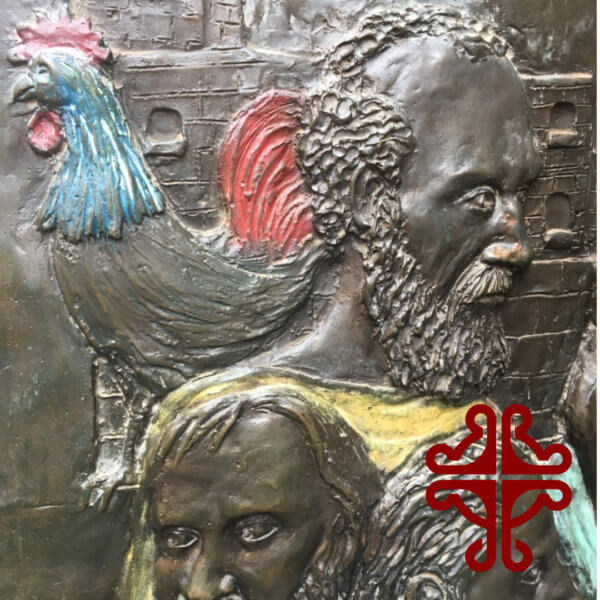
Authentic Lent
 Here we are. It’s Good Friday. After a Lent of unprecedented authenticity — at least in my experience — we have now walked through a Holy Week that has also felt incredibly challenging and real. One of the special gifts of our quarantine and online worship is that we are able to worship with other communities as well as with our own.
Here we are. It’s Good Friday. After a Lent of unprecedented authenticity — at least in my experience — we have now walked through a Holy Week that has also felt incredibly challenging and real. One of the special gifts of our quarantine and online worship is that we are able to worship with other communities as well as with our own.
I worshiped again today with my dear friends at St. George’s Cathedral in Jerusalem, walking the Stations of the Cross with Archbishop Suheil and bishop-elect Hosam. They were alone inside the cathedral because of the quarantine, with only Saleem, a seminarian, holding the iPhone on Facebook Live as they processed, prayed, and sang. Usually they would walk the Stations of the Cross in the Old City, along the Via Dolorosa — the way of sorrows — the actual path that the church remembers Jesus walked on the way to Golgotha to his crucifixion. But even inside the cathedral, stopping before the Armenian tile representations of Jesus’ last walk through the ancient stone streets of Jerusalem — the sheer enormity of Good Friday was almost overwhelming.
Caiaphas’s House
The Passion from the Gospel of John, like the Passion from Matthew, begins in the Garden of Gethsemane, at the base of the Mount of Olives, and across the Kidron Valley looking up at the Temple Mount in the Old City of Jerusalem. Jesus is arrested in the Garden of Gethsemane, and then taken across the Kidron Valley, past the ancient tombs of the Prophets, and then to the house of Annas, father-in-law of Caiphas, the high priest that year. They served in rotation, one year off, one year on.
Across the Kidron Valley from the Garden of Gethsemane — outside the walls of the Old City — is the ancient structure archeologists believe was Caiaphas’s house. It’s a chilling place, and it’s difficult ever to read the Passion narrative the same way after walking through it. There is a stone prison hewn into the rock hillside of Mount Moriah, the mountain that the Old City of Jerusalem sits on. There are vast holes in the rock that prisoners could be chained to. And there is a deep pit, that makes all the psalms that implore God to keep us out of the pit seem much more real too. There is a Roman Catholic church built over the first century high priest’s house, that like most churches in the Holy Land starts with a 4th century church at the bottom, with a Crusader structures over and around it, and then the 20th century church on top.
Gallicantu
 The church is called Gallicantu — from the word gallus for rooster, and canto (like cantor, or chant) for sing or crow. It’s the church of the cock crow, because it was there in the courtyard that Peter fulfilled Jesus’ prophecy that despite Peter’s love and loyalty to Jesus, before the cock crowed at dawn, Peter would deny ever knowing Jesus. There is a beautiful brass bas relief of a rooster on the front door of the 20th century church.
The church is called Gallicantu — from the word gallus for rooster, and canto (like cantor, or chant) for sing or crow. It’s the church of the cock crow, because it was there in the courtyard that Peter fulfilled Jesus’ prophecy that despite Peter’s love and loyalty to Jesus, before the cock crowed at dawn, Peter would deny ever knowing Jesus. There is a beautiful brass bas relief of a rooster on the front door of the 20th century church.
Before I spent time at Gallicantu last year, I always had my focus on Jesus in the Passion narrative. Gallicantu gives us another perspective, and invites us to walk with Peter and see where WE stand in this drama. There is a chapel in Gallicantu down low in the Crusader level of the church that focuses on Peter as he realizes that Jesus’ prophecy of Peter’s betrayal has been fulfilled. Beautiful tile mosaics depict Peter’s anguish. We can feel as we read the passion narrative that was not where Peter saw himself going. It wasn’t how Peter expected the story to turn out, or how he thought he would respond when tested. In John’s gospel, bystanders in the courtyard of Annas’s house ask if Peter is one of Jesus’ disciples, because they saw him with Jesus.
But in the Passion in Matthew’s gospel, Peter both betrays Jesus and Peter HIMSELF is betrayed by his own humanity. Two different servant girls recognize Peter and say that they saw Peter with Jesus the Galilean. Peter denies that he knows Jesus both times. Then the bystanders — maybe the same and more servant girls, and maybe others — approach Peter. They say surely you are also one of them for your accent betrays you. Peter, who loved Jesus so much that he promised he’d rather die with Jesus than to desert him, betrays Jesus just as Jesus foretells he will.
And his Galilean accent betrays Peter’s desertion, the flaw in Peter’s own character. Peter’s Galilean accent. His dialect. The way they talk back home, in Galilee, where Peter’s from — and Jesus too. Galilee is the place Peter grew up, lived, worked, loved. Galilee is the place of Peter’s formation as a human being, and his accent, the way that his people talk back home, is the very thing that has betrayed him. It’s the most human part of him — the way he has learned to talk — the accent that is as much a part of home for him as the stones and dirt he walked on in Capernaum. That accent has betrayed him, exposing his own humanity and brokenness.
We’re All Broken
We’re all broken. It’s a condition of our humanity, as much a part of our formation as the dirt we walk on, the air we breathe, and the way our people talk from the time we are babies. Our accent betrays us.
Jesus came to redeem us and to restore us to wholeness through his own fully human and fully divine nature. He knows Peter will desert him before it happens. He knows before Peter does. Peter’s humanity makes the desertion inevitable. His accent has betrayed him.
Now we wait. After the most authentic Lenten seasons — and most real and present Holy Weeks in most of our lives — even though we’re not worshiping in the church as we usually do — we wait. We know our humanity and wait and hope for Easter. Amen
Prayer
Gracious and merciful God, forgive us our trespasses and weaknesses. Forgive us our fragility and susceptibility to self-focus. Forgive us our many flaws, which are as much a part of us as our own accents, which you know but we cannot recognize in ourselves. Give us the strength and courage to to love and serve you, and to understand that to love you is to take on the hard work of wrestling with our own humanity. We ask all this in Jesus’ name. Amen
Were You There When They Crucified My Lord, sung by DeWayne Trainer and accompanied by Mark Pye, my dear choir friends from All Saints’ Atlanta
https://www.facebook.com/697626178/posts/10157044103381179/
